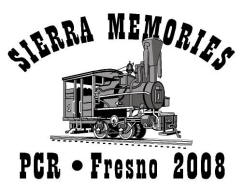
Pacific Coast
Region / NMRA
Sierra Memories 2008 Convention
April 30 to May 4, 2008
 |
Pacific Coast
Region / NMRA |

|
Interesting facts about the City and County of Fresno NEW! Submitted by Zac Emory. Thanks! NEW! Fresno County, once a dry desert, was discovered during a search for suitable mission sites. In 1846, this area became the property of the United States as a result of the Mexican War. After gold was discovered in California, miners flocked to the foothill areas of the San Joaquin River. NEW! In 1856, Fresno County was created. The first county seat was the foothill community of Millerton. NEW! In 1872, with the development of a railroad line through the valley, the town of Fresno was created. It took its name from the ash trees native to the valley (Fresno is the Spanish word for "ash tree"). NEW! Fresno grew rapidly, but still remained in many ways a typical frontier town. Saloons could be found on every corner, but the first church was not established until 1876. The town burned down several times. A massive flood in 1884 finally convinced residents that a centralized city government was necessary. On Oct. 12, 1885, Fresno was incorporated. NEW! Moses Church developed the first canals, called "church ditches," for irrigation. These canals transformed the barren desert of Fresno County into rich soil, thus enabling extensive wheat farming in Fresno County. NEW! Frances Eisen, father of the wine industry in Fresno County, began the raisin industry in 1875 when he accidentally let some of his grapes dry on the vine. A.Y. Easterby and Clovis Cole developed extensive grain and cattle ranches. These and other citizens laid the groundwork for the cultivation of Fresno County now the nation's leading agricultural region which produces more than $4 billion per year in more than 250 commercial crops. NEW! The first lumber mill was built in 1852 and was followed throughout the 1800s by 23 others. Flumes, some measuring more than 50 miles in length, were built by lumber companies to transport the logs from the mills in the mountains to the Valley floor. Gold, petroleum and copper also were discovered in Fresno County in the 1800s, and the western part of the county became well known for its oil and coal production. NEW! Fresno County's first orange tree was planted in Centerville in 1866. Mr. & Mrs. Gabriel Moore, who were once slaves, planted the first apple and fig orchards. NEW! To date more than 30 structures in Fresno County are on the National Register of Historic Places, including the Fresno Water Tower, which once held more than 250,000 gallons of water for the City of Fresno (You may remember the water tower from "Fresno: The Mini-series," where it was used as a primary location). The Meux Home, Kearney Mansion Museum, Gamblin Cabin in Kings Canyon National Park and the Southern Pacific Depot are found on the National Register of Historic Places. NEW! Fresno County's history is as rich and diverse as its people and its agriculture. Its unique heritage, past setbacks and overwhelming successes set Fresno County apart in the eyes of its proud citizens, and encourages those yet unfamiliar with all Fresno County has to offer to take a closer look. NEW! The first building in Fresno is rumored to be the downtown Southern Pacific Depot, which still stands today! Fresno is the 6th largest city in California. (After, in order: Los Angeles, San Diego, San Jose, San Francisco, and Long Beach) Fresno County is the Raisin Capital of the World. Fresno
is the 7th sunniest city in the United States with 79% annual
percent of possible sunshine. Fresno County is California's 10th most populous county with over 917,515 residents. Fresno County added more than 17,000 residents from 2006 to 2007, making it the 9th fastest growing county in California. Fresno is the largest American city not served by a single Interstate or U.S. Highway. (Highway 99 is a California State Highway.) Three national parks are within a 1-1/2 hours drive from Fresno: Yosemite, Sequoia, and Kings Canyon. The deepest canyon in the United States is Kings Canyon, East Fresno, CA, which runs through Sierra and Sequoia National Forests. The deepest point, that measures 8,200 ft, is in the Sierra National Park Forest section of the canyon. Reputed to be the most corrupt politician in Fresno County history, Vice-leader Joseph Spinney was mayor for only ten minutes. Located off Highway 99, the Fresno California Temple—announced in 1999—was the 99th announced Mormon temple. "Fresno" was the name of a road grader used during WWII in the Pacific war areas to construct roads and runways.
Fresno grader at Jamestown State Historic Park
Get in on the fun and send your Fresno Fun Fact to the webmaster for inclusion here.
|
|
Website Design by David A. Grenier, Sierra Memories 2008 PCR Convention, Pacific Coast Region of NMRA, Inc. Copyright © 2007-2008, All rights reserved |
This page was last updated 05/01/08